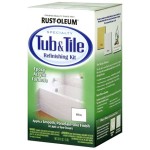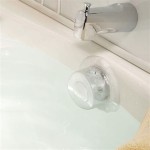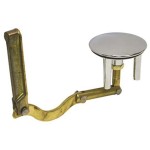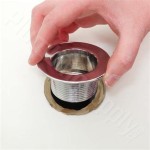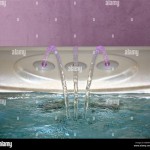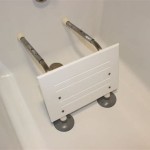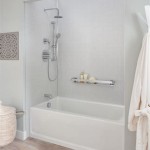Building Your Own Bathtub With Tile: A Comprehensive Guide
Constructing a custom bathtub using tile offers a unique opportunity to personalize bathroom design and create a luxurious bathing experience tailored to individual preferences. This project, while demanding in terms of planning and execution, can result in a visually stunning and highly functional bathroom feature. This article provides a comprehensive overview of the process, covering essential considerations, material selection, construction steps, and important sealing techniques.
Planning and Design Considerations
The initial phase of building a tiled bathtub centers on meticulous planning and detailed design. This stage is pivotal in determining the final outcome and ensuring structural integrity. Before commencing any physical work, several key factors must be thoroughly evaluated.
Structural Integrity: The underlying framework of the bathtub must be robust enough to support the considerable weight of water, the bather, and the tiling materials. This necessitates a solid foundation and a structurally sound support system. Consider the existing floor joists and whether they require reinforcement to handle the added load. Consulting with a structural engineer is highly recommended, especially for larger or more complex designs. A properly supported framework prevents cracking, leaks, and potential structural failure.
Dimensions and Shape: The dimensions of the bathtub should be carefully considered in relation to the overall bathroom layout and the intended user's comfort. Measure the available space accurately, taking into account clearances for entering and exiting the tub, as well as any surrounding fixtures. The shape of the bathtub can range from simple rectangular designs to more elaborate curved or angled configurations. The chosen shape will significantly impact the complexity of the construction and tiling process. Consider the ease of cleaning and maintenance when selecting the shape. Complex curves and intricate corners can be more challenging to keep clean.
Drainage and Plumbing: Proper drainage is crucial for the functionality of the bathtub. Carefully plan the location of the drain and ensure that it is properly connected to the existing plumbing system. The plumbing connections should be readily accessible for future maintenance or repairs. Consider the slope of the bathtub floor towards the drain to facilitate efficient water drainage. A slight slope (approximately 1/4 inch per foot) is generally sufficient. Hire a qualified plumber to handle the plumbing connections and ensure compliance with local building codes.
Waterproofing: Effective waterproofing is paramount to prevent water damage and mold growth. The entire interior surface of the bathtub must be thoroughly waterproofed before tiling. Select a high-quality waterproofing membrane that is specifically designed for wet environments. Apply the waterproofing membrane according to the manufacturer's instructions, paying particular attention to seams and corners. Ensure that the membrane extends sufficiently up the surrounding walls to prevent water from seeping behind the tiles.
Tile Selection: The choice of tile will significantly impact the aesthetic appeal and functionality of the bathtub. Consider factors such as durability, water resistance, slip resistance, and ease of cleaning. Porcelain and ceramic tiles are popular choices for bathtubs due to their water resistance and durability. Mosaic tiles can be used to create intricate designs and add visual interest. Ensure that the selected tile is compatible with the chosen waterproofing membrane.
Construction Process: Step-by-Step Guide
The construction of a tiled bathtub involves a series of steps, each requiring meticulous attention to detail. The following outline provides a comprehensive guide to the construction process.
Building the Frame: Construct a sturdy frame using pressure-treated lumber. The frame should be designed to support the weight of the water, bather, and tiling materials. Adhere to the planned dimensions and shape. Ensure that the frame is level and plumb. Reinforce the corners and joints with screws and/or construction adhesive. The frame should be securely anchored to the floor and surrounding walls.
Installing the Substrate: Cover the frame with a cement backer board or a similar waterproof substrate. Cement backer board provides a stable and water-resistant surface for tiling. Cut the backer board to size and attach it to the frame using screws designed for cement board. Stagger the seams of the backer board to minimize the risk of cracking. Tape and mud the seams with cement board tape and thin-set mortar to create a smooth and seamless surface.
Waterproofing Application: Apply a high-quality waterproofing membrane to the entire interior surface of the bathtub, including the floor, walls, and corners. Follow the manufacturer's instructions carefully. Apply multiple coats of the membrane, allowing each coat to dry completely before applying the next. Pay close attention to seams, corners, and areas around the drain and plumbing fixtures. Reinforce corners and edges with waterproofing fabric or sealant for added protection.
Tile Installation: Begin tiling the bathtub, starting with the floor and working upwards. Apply thin-set mortar to the back of the tile and press it firmly into place. Use tile spacers to ensure consistent grout lines. Use a tile saw to cut tiles to fit around corners and edges. Regularly check the level and alignment of the tiles. Allow the thin-set mortar to cure completely before grouting.
Grouting and Sealing: After the thin-set mortar has cured, apply grout to fill the spaces between the tiles. Select a grout color that complements the tile. Use a grout float to push the grout into the joints, ensuring that they are completely filled. Wipe away excess grout with a damp sponge. Allow the grout to cure completely before sealing. Apply a grout sealer to protect the grout from staining and water damage. Seal the perimeter of the bathtub where it meets the surrounding walls with a high-quality silicone sealant to prevent water from seeping behind the tiles.
Material Selection and Considerations
The proper selection of materials is crucial for the longevity and performance of a tiled bathtub. Consider the following factors when choosing materials.
Lumber: Use pressure-treated lumber for the frame to resist rot and decay. Select lumber that is straight and free from knots or defects. Ensure that the lumber is properly sized to support the weight of the bathtub. Consider using kiln-dried lumber to minimize warping and shrinkage.
Cement Backer Board: Choose a cement backer board that is specifically designed for wet environments. Select a thickness that is appropriate for the application. Ensure that the backer board is compatible with the chosen waterproofing membrane. Avoid using drywall or plywood as a substrate, as these materials are not water-resistant.
Waterproofing Membrane: Select a high-quality waterproofing membrane that is specifically designed for use in bathtubs and showers. Choose a membrane that is easy to apply and provides excellent protection against water damage. Consider using a liquid membrane, sheet membrane, or a combination of both. Ensure that the membrane is compatible with the chosen thin-set mortar and grout.
Thin-Set Mortar: Use a thin-set mortar that is specifically designed for use with the chosen tile and substrate. Select a mortar that is waterproof or water-resistant. Follow the manufacturer's instructions for mixing and application. Ensure that the mortar is compatible with the chosen waterproofing membrane.
Grout: Choose a grout that is suitable for wet environments and resistant to staining and mold growth. Select a grout color that complements the tile. Consider using epoxy grout for added durability and water resistance. Apply a grout sealer to protect the grout from staining and water damage.
Tile: Select a tile that is durable, water-resistant, and slip-resistant. Choose a tile size and shape that is appropriate for the design of the bathtub. Consider using porcelain or ceramic tiles for their water resistance and durability. Ensure that the tile is compatible with the chosen thin-set mortar and grout.

Bathtub Is It Affordable And Reasonable To Create A Tub Using Tile Home Improvement Stack Exchange

Custom Shape Tile Bathtub And Shower

Bathtub Covering With Contemporary Design Kronos Ceramiche

Just Finished The Custom Shower Bathtub In My Apartment All Made Out Of Tile Imgur

Bathtub Covering With Contemporary Design Kronos Ceramiche

How To Build A Custom Tub In 10 Steps 2024 Badeloft

Build Your Own Bathtub Size For My Master Bath Another Self Design So Make Tub

Bathtub Covering With Contemporary Design Kronos Ceramiche

Custom Stone Bathtub And Shower Makeover With Wooden Wall Tiles

Tiling A Bathtub Panel 4 Steps With Pictures Instructables

